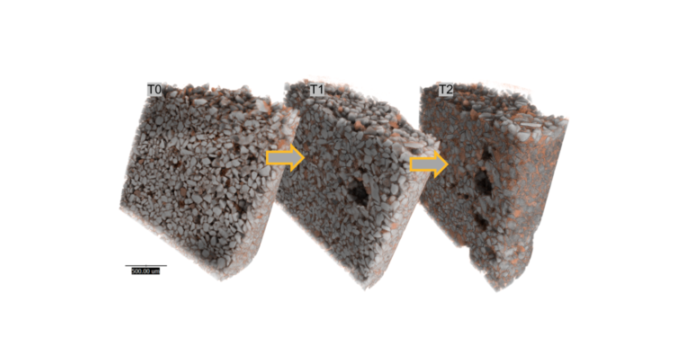Micro XCT research example: Binder saturation analysis for metal 3D printing
XCT analysis of powder/binder interaction to determine binder saturation and assist in densification and strengthening of final parts produced by binder-jet printing
Binder jet 3D printing (BJP) produces parts by selectively binding a powdered substrate with a liquid binder, layer by layer, until a part is formed. Recent developments in BJP include the use of reactive binders that contribute to the densification of parts, instead of being removed during sintering as with traditional binders. Reactive binders include metalorganic components that decompose into beneficial materials that help fill the pores left between powder.
Iron ore has never been considered as a suitable substrate for use in BJP. The use of XCT has allowed for the characterisation of particle size, surface geometry, porosity, and sphericity of the particles; all of which contribute to how well a powder will perform in a printer. Being able to print with iron ore would allow for selective agglomeration of the ores to prepare it as feedstock for the blast furnace. Bespoke geometries that can be controlled with BJP would allow for a more efficient operation of the blast furnace and would replace existing thermal agglomeration techniques which are energy intensive and contribute up to 20% of all CO2 emissions within the ironmaking sector. Additionally, the use of a reactive binder can further improve the blast furnace feedstock by agglomerating the iron ore powder with beneficial chemistries to improve iron yield and reduce coke consumption in the blast furnace.

XCT was used to observe the interaction of the reactive binder with the powdered iron ore. The ore was scanned on its own, then, without disturbing the powder, binder was added to the ore, allowed to dry and scanned again, then repeated once more. Due to the varying densities of the cured binder and ore, it was possible to observe areas that the binder had settled, and what percentage of the pores the binder had filled, allowing for printing parameters to be determined to help achieve binder/powder saturation within the print bed in order to achieve stronger green parts.
The images shown here were created with Drishti from Zeiss Xradia Versa data.